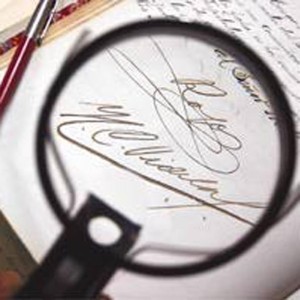Graphology: A Deductive Dive Into The World Of Handwriting Analysis…
Before we begin here’s a few words on the subject of Graphology from Sherlock Holmes and Professor Moriarty in the film “Sherlock Holmes: A Game Of Shadows” courtesy of Warner Brothers:
This interaction actually brings up a few points I want to make before we actually jump into learning about handwriting analysis. You’ll notice that Moriarty, a scholar, says “I’ve never given it any serious thought.” This is actually true of many scholars today. When it comes to Graphology there is a mixed bag of opinions on its usefulness and/or legitimacy I would like to address this and give you my thoughts on the matter.
 While the study of Graphology is widely accepted there are those who use nothing more than Cold Reading under the guise of Graphology. In other words, they pretend to be ascertaining information from the subjects handwriting when in reality they are making declarations that would apply to anyone. Much like the weekly horoscope in newspapers, they are general yet feel specific. This is known as the Barnum, or Forer Effect. Due to this many have snubbed their nose at Graphology as a whole.
While the study of Graphology is widely accepted there are those who use nothing more than Cold Reading under the guise of Graphology. In other words, they pretend to be ascertaining information from the subjects handwriting when in reality they are making declarations that would apply to anyone. Much like the weekly horoscope in newspapers, they are general yet feel specific. This is known as the Barnum, or Forer Effect. Due to this many have snubbed their nose at Graphology as a whole.
On the other hand there are entire institutes devoted to Graphology and many professionals, myself not excluded, that can deduce accurate psychological traits of a person based on their handwriting. Just like in any other arena there are charlatans that give the art a questionable name. In this article I will be sharing the methods and techniques that I’ve found to be quite reliable in this field. As always, confirm your deductions with evidence, and see for yourself what works, and what simply does not. Interestingly enough as a performer I have often used advanced cold reading combined with legitimate Graphology to achieve amazing results, for theatrical purposes.
The above video is an example of that, while Sherlock did state some valid Graphology techniques he also used what he already knew of Moriarty to be ‘more’ specific than he would have been otherwise. With that being said, let us begin.
Graphology is the pseudo-scientific study and analysis of handwriting, especially in relation to human psychology. The term is sometimes incorrectly used to refer to forensic document examination. Forensic document examination is a science used to ascertain the validity as well as other aspects of documents in a court of law. Graphology however, focuses on psychological traits that can be ascertained from one’s handwriting.
Graphology has been controversial for more than a century. As I stated earlier, many of us that study this art have found many of it’s teachings to be quite useful, while at the same time many of it’s larger more fantastical claims to be just that. Again, I will only be teaching the techniques that I’ve personally found to be of use in my work. Graphology depends on a few simple assertions, they are as follows:
When we write, the ego is active but it is not always active to the same degree. Its activity waxes and wanes; being at its highest level when an effort has to be made by the writer and at its lowest level when the motion of the writing organ has gained momentum and is driven by it.
When the action of writing is comparatively difficult, the writer uses those forms of letters which are simpler or more familiar.
The muscular movements involved in writing are controlled by the central nervous system. The form of the resultant writing movement is modified further by the flexibly assembled coordinative structures in the hand, arm, and shoulder; which follow the principles of dynamical systems. The specific writing organ (mouth, foot, hand, crook of elbow) is irrelevant if it functions normally and is sufficiently adapted to its function.
The neurophysiological mechanisms which contribute to the written movement are related to conditions within the central nervous system and vary in accordance with them. The written strokes, therefore, reflect both transitory and long term changes in the central nervous system such as Parkinson’s disease, or alcohol usage.
The movements and corresponding levels of muscular tension in writing are mostly outside of conscious control and subject to the ideomotor effect. Emotion, mental state, and biomechanical factors such as muscle stiffness and elasticity are reflected in a person’s handwriting.
One must examine the handwriting or drawing movements by considering them as movements organized by the central nervous system and produced under biomechanical and dynamical constraints. Given these considerations, graphologists proceed to evaluate the pattern, form, movement, rhythm, quality, and consistency of the graphic stroke in terms of psychological interpretations. Such interpretations vary according to the graphological theory applied by the analyst.
Most schools of thought in graphology concur that a single graphological element can be a component of many different clusters, with each cluster having a different psychological interpretation. The significance of the cluster can be assessed accurately by tracing each component of the cluster back to their origins and adapting the meaning of the latter to the conditions of the milieu in which the form appears.
No single handwriting feature proves anything specific or absolute by itself; a single feature alone can only identify a  trend. It is the combination of features, and the interaction between them that enable a full and clear interpretation. Graphology is actually very old, the study of handwriting and its analysis was first developed by the Chinese 3,000 years ago. The Romans used graphology, and through the centuries since then various civilizations and cultures have analyzed handwriting to identify the essence of the person who produced it.
trend. It is the combination of features, and the interaction between them that enable a full and clear interpretation. Graphology is actually very old, the study of handwriting and its analysis was first developed by the Chinese 3,000 years ago. The Romans used graphology, and through the centuries since then various civilizations and cultures have analyzed handwriting to identify the essence of the person who produced it.
The modern approach to handwriting analysis was established by a group of French clerics, led by Abbe Michon, who defined key aspects of the science in the 1870s, after 30 years of study. This work formed the basis of modern graphology, although the science is still being researched and expanded today. We will now dive into some of the teachings I find to be the most interesting and useful.
First we will talk about the ‘perfect’ handwriting sample. While an experienced Graphologist can work with nearly any handwriting sample, most professionals agree that for the most accurate analysis you should follow a few rules in gathering your sample. You may or may not believe it but even if you try to manipulate your handwriting, a graphologist scholar will tell you who you are, by merely analyzing your handwriting. However, there are a few prerequisites that one needs to follow.
1. It is best to use non ruled/unlined paper.
2. The pen used by the writer should be the regular one he/she uses. A fountain pen or a ball point is ideal. Pencils are generally frowned upon.
3. The ideal writing sample is at least 100 words, although this is not an absolute.
4. Anything that has been copied from another document, like a poem, will reflect the original and is frowned upon.
Having said that, let’s get into the actual handwriting analysis itself… Finally… 

The three zones in Graphology, these will be referenced often.
Baseline
This refers to the direction written across the page. For example, if the paper was lined, a straight baseline would be writing that is written directly on the line all the way across the page. As found in every book or printing.
Generally Straight: Often indicates that the writer needs control in his/her life to be comfortable.
Ascending to the Right: Optimistic, looks forward to the future, excitable, joyous and invigorated.
Descending Slant: Pessimism, fatigue, discouraged, depressed, can also indicate many forms of illness.
Arc: An arc shaped baseline more often than not indicates one who often does not follow through, quite often a writer that would start a project enthusiastically yet later gives up and leaves things unfinished.
Concave: The writer is generally a slow starter and lacks confidence or purpose. However, as the project begins, the writer will overcome the negativity. It is difficult for this writer to start a project but easier to finish one.
Slant
Left Slant: Most of the strokes will end up at an angle to the left of 90 degrees. People with this trait can often have a hard time expressing their feelings and connecting with other people. In context this can often indicate lack of trust. This writer needs to be true to self first and foremost and can be resentful if others try to push for more commitment from them.
Right Slant: Indicative of a person ruled by their heart and not their head. This is known to be a person who is impulsive and lets their emotions rule their life more so than the emotionally withdrawn person.
Straight: If the handwriting is mostly upright, this can indicate independence and/or confidence. More-so than the left or right slant writer. Again, there are no absolutes here.
Uneven Slant: In graphology whenever the writing becomes uneven then this means that the writer is moody or at is least experiencing different moods while writing.

This is a very general diagram of Slant in Graphology.
Size
Handwriting is made up of three zones, middle, upper and lower. A basic average measure or baseline by which size can be judged is 3mm per zone. This gives a baseline for a non-remarkable full height of 9mm. More than this is large; less than this is small. See the above diagram.
Large size handwriting can mean extroverted and outgoing, or it can mean that the writer puts on an act of confidence, although this behavior may or may not be exhibited to strangers.
Small size can, obviously, mean the exact opposite. Small size handwriting can also indicate a thinker or an academic, depending upon other features in the sample.
If the writing is small as well as delicate, this often indicates shyness. The writer is unlikely to be a good communicator with anyone other than those they feel a level of rapport with. These people do not generally find it easy to be outgoing socially.
Pressure
Heavy pressure: Generally indicates commitment and a serious personality, however if the pressure is unusually heavy, that person could tend to be very uptight at times and can react quickly to constructive criticism. Such individuals tend to react first and ask questions afterwards.
Light pressure: Shows sensitivity to surroundings and empathy to people, yet can also indicate, if the pressure is uneven, show lack of vitality and drive or motivation.
Rhythmic Changing Pressure: Artistic, aesthetic, warm, likes colors, charming personality. If pressure is absent on the left-descending upper zone strokes, a fear of the past is implied. If the pressure is present on the right-ascending upper zone strokes then, one suspects something fearful in the future. Sudden intensity in the pressure can show quick temper or emotional intensity.
Upper Zone or Case (shown often in: l, t, h, etc…)
Tall upper strokes that reach into the upper zone can indicate reaching towards goals and/or ambitions. Yet if they are extremely extended, this is generally indicative of unrealistic expectations and/or one that sets unreachable goals.
Some Graphologists teach that if the upper zone loops are average in size the writer would tend to be someone who likes to think things through and is sensible. Larger and wider upper zone loops likewise indicate a dreamer and/or one who ponders their ideas/goals excessively.
Word Spacing
The baseline to judge wide or narrow spacing between words is the width of one letter of that particular person’s handwriting. Wide spaces between words often indicate, quite simply, someone needing/wanting space at the time of writing or in general, depending on the context.
Narrow spaces between words indicate a a wanting or longing to be with/around others, but such writers may also crowd people and be intrusive, and context is key here.
Line Spacing
Handwriting samples are always best on un-ruled/unlined paper, especially for deductions regarding line-spacing features.
Wide-spaced lines of handwriting can indicate an observer, one who prefers to stand back from the crowd.
Closely spaced lines indicate that that the writer operates up close and personal, so to speak.
Middle Zone Types:
Arcade
This means that the middle zone of the writing is rounded at the top like a series of arches. Nearly all Graphologists agree that arcade indicates one who is loyal, protective, independent, trustworthy and methodical, yet on the negative flipside they can be secretive, stubborn and hypocritical when they choose. The most important characteristic is group solidarity against outsiders. While this can apply to all people, it is taught that the arcade writer exhibits these particular traits moreso than others.
Garland
Garland is quite simply an inverted ‘arcade’ and is a people-orientated social style of writing. These writers make their m’s, n’s and h’s in the opposite way to the arcade writer, very much like cups, in this sense cups into which people can pour their troubles or just give information, empathetic, a receiver The Garland writer generally enjoys being helpful and likes to be involved.
Angled
Angled middle zone is the analytical style, the sharp points, rather than curves, give the impression of a penetrating and/or piercing personality. The angle writer, is often better at employing talents at work projects, rather than nurturing, which is the strength of the garland writer.
Important: As with any indicators of personality, these interpretations do not mean that each writer needs to be categorized and prevented from spreading their talents and interests, just traits that have been found to be more common is such writers, and worthy of noting.
Thread (I generally pay little attention to this form)
Thread handwriting is a unique form of handwriting, very much resembling unraveled wool or strands of thread. Writers who have thread handwriting have often been noted as more alert and flexible, and can adapt to a variety of situations. On the other hand, these writers can also be elusive and impatient. It is widely accepted that thread writers are observant, and can often easily put bits of information together into one piece. A thread writer is someone is more apt to respond to a situation, rather than initiate it.
Wavyline
Wavyline handwriting is quite often, and simply put an culmination of all or most of the other forms and is usually employed by people who are, for the most part, mentally mature and skillful It shows that they can call on a variety of styles psychologically, to suit the occasion. This indicates good coping mechanisms. They are adaptable and resourceful.
————————————————
 Well there you have it, a brief deductive dive into the world of handwriting analysis. Professional Graphologists teach a vast array of terms and their corresponding psychological traits, literally hundreds more than I have covered here. I have purposefully left them out. Most, if not all of them are unreliable at best. What I have covered in this article are the most WIDELY accepted and reliable techniques. Ones that I have used in my work and have found success with. I have studied this topic for many, many years and narrowed down the methods that have given me the best results.
Well there you have it, a brief deductive dive into the world of handwriting analysis. Professional Graphologists teach a vast array of terms and their corresponding psychological traits, literally hundreds more than I have covered here. I have purposefully left them out. Most, if not all of them are unreliable at best. What I have covered in this article are the most WIDELY accepted and reliable techniques. Ones that I have used in my work and have found success with. I have studied this topic for many, many years and narrowed down the methods that have given me the best results.
I suggest anyone reading this to start analyzing handwriting of people you know, as well as your own. Many Graphologists like to analyze samples of handwriting from famous people and politicians. In the age of the internet it has become easier than ever before to gather samples. Have fun with this and as always…
“Observe carefully, deduce shrewdly, and confirm with evidence.” -Dr. Joseph Bell
—————————————————————————————————
Joe’s book (raising funds for Save Undershaw) ‘The Real Sherlock Holmes‘ is available all good bookstores including Barnes and Noble, Amazon, and in all formats including Amazon Kindle and now on the iPad too. Fans outside the US and UK can get free delivery from Book Depository.








